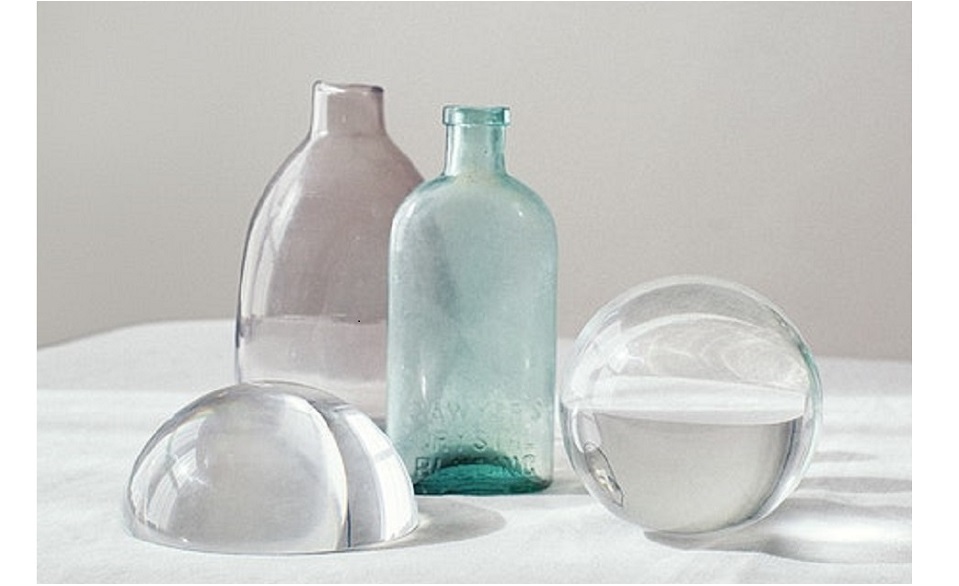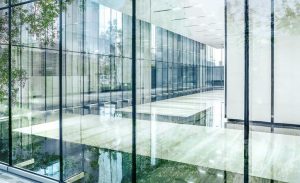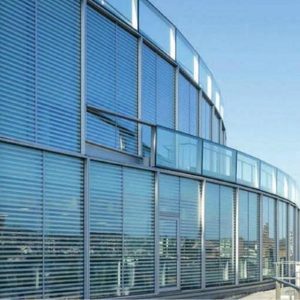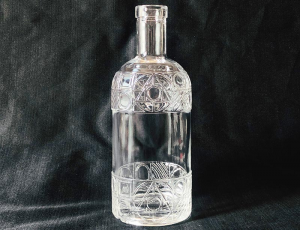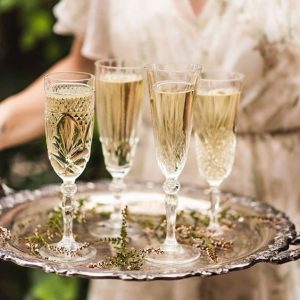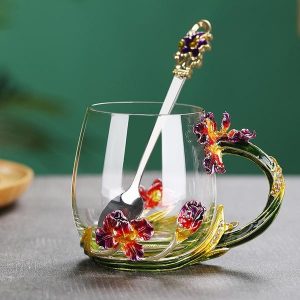Glass can be for Building and Daily Package
Glass materials can be easily found around us. Glass is widely used in architectural or building industry and also commonly be used for daily products packaging. For building, glass is most typically used as transparent glazing material in the building envelope, including windows in the external walls. Glass is also used for internal partitions and as an architectural feature. When used in buildings, glass is often of a safety type, which include reinforced, laminated, and tampered glasses. We can see glass bottle and jars in the kitchen, coffee bar and supermarket shelves. When used in daily packaging, glass bottles and jars can be used for food and beverage package, pharmaceutical usage, health, and beauty products.
Laminated Glass
Laminated glass is made by bonding two layers of glass with a layer of resin, commonly polyvinyl butyral (PVB). The PVB is the interlayer that holds the glass layers together, even when the glass breaks or impacted by a great force. The process of producing laminated glass involves bonding these glass layers and the interlayer under heat and pressure. The interlayers work to support and hold the glass to create a strong, uniformed layer even when broken. Laminated glass comes in varying thicknesses can be created using different glass combinations or coatings to provide different qualities, such as low emissions or increased insulation.
Benefits of Laminated Glass
- The plastic interlayer holds the structure intact when broken – making it impact-resistant.
- Because the structure is held intact upon impact, this makes it ideal for security
- Increases safety as the shards do not scatter as widely and are instead held in place by the plastic sheet
- Has sound reduction properties and also works to block out a large proportion of UV radiation
Laminated glass is perfect for places where enhancing security is paramount such as shop fronts, external and internal doors, ground floor glass, domestic and residential buildings.
Tampered Glass
Tempered glass or toughened glass is a high-strength glass that is up to 5 times stronger than ordinary glass. To make toughened glass, a standard strength pane of glass is heated to a high temperature and then rapidly cooled – forming an incredibly durable outer layer that can withstand impacts and temperature changes with ease.
Tempered glass is produced in the process of toughening standard glass to give stronger glass. In fact, this toughening process makes it several times stronger than laminated glass. This process often involves heating, high-pressure, and chemical treatment procedures.
These treatments give the glass a better balance of internal stress, which makes it better at resisting force up to certain levels.
Features of Tampered Glass
- When broken, it smashes into smaller, blunter pieces as opposed to dangerous shards
- Highly durable, making it difficult to break
- Has incredible thermal resistance, and can cope with intense temperate
- Up to five times the strength of ordinary glass
Tampered glass applications
where durable and heat-resistance glass are sought such as worktops, greenhouse glass, shower screens, splashbacks, balustrades, and monitor screens.
Daily Used Glass
There are 3 main types of daily used package glass. They differ in terms of their chemical composition, the method used to produce them or their processing behaviour. Soda-lime glass, lead glass and borosilicate glass make up around 95 percent of the cullet glass used in the production process.
Soda-lime glass
Soda lime glass is the most commonly produced type of glass bottles, making up 90% of all glass manufactured. Having been manufactured for hundreds of years, it is a basic combination of silica, soda, and lime with a variety of useful properties for applications across a variety of industries, including the consumer goods manufacturing, packaging, and scientific sectors. Soda lime glass is often compared with its cousin, borosilicate glass.
The Chemical Property of Soda Lime Glass Bottle
Soda lime glass is made mostly from three basic components. The first material is silica, or silicon dioxide, which makes up 70% of the finished product. Another 15% is made of soda, or sodium oxide, which lowers the silica’s melting temperature, and lime, also known as calcium oxide, makes up another 9% to act as a stabilizer. The remaining 6% is made up of trace elements.
Soda lime glass has several properties that make it useful as a glass for general and more specific applications.
Features of Soda Lime Glass Bottle
It is cheap. Soda lime glass is less expensive than other glass with more specialized properties, such as borosilicate or optical glass.
It is chemically stable. The atoms in soda lime glass have strong atomic bonds and are highly connected, making it difficult for other substances to affect its structure and corrode the glass. This makes it good for use around chemicals, especially if tempered to increase its thermal shock resistance. Soda lime glass is not entirely immune to chemical wear, however, and other more specialized glasses can be more resistant.
It is hard. Soda lime glass is a 6-7 on the Mohs hardness scale, which measures how resistant to abrasion material is. This highest score on this scale is ten and includes materials like diamond. Soda lime glass can also, however, be tempered by heat or chemicals to be made three times stronger. Chemical tempering gives it more mechanical strength, making it harder and more scratch resistant. Heat strengthening also provides the glass with mechanical strength, with the bonus of making it more resistant to sudden changes in temperature.
It is workable. Thanks to the soda and lime in soda lime glass, it can be softened and resoftened many times without quality loss. This attribute makes it a good material for recycling.
It is vulnerable to thermal shocks. Sudden temperature changes can shatter soda lime glass. This can be reduced by heat tempering, which gives this material added strength.
It is an electrical insulator. Glass does not transmit electricity well, as it has a high specific resistivity and a low dielectric constant. That makes it useful for insulating electrical products.
It transmits visible light. Soda lime glass’s refractive index is roughly 1.5, which means only about 4% of the light that hits it is reflected. The rest passes through, making it an excellent material for applications where light transmission is important.
Lead glass or Crystal glass
“crystal” glass contains no crystal at all, but rather has lead or zinc added to make it look like crystal. Traditionally, “crystal” glass was just regular glass where the calcium is replaced with lead oxide. A more accurate name is therefore “lead glass“. Adding lead to glass raises its index of refraction. Crystal glass looks beautiful when cut as a result of its high refraction index. It has a far higher density than soda-lime glass. The index of refraction measures the amount that a material bends light. Materials with a higher index of refraction sparkle more because they bend light more. One of the materials with the highest index of refraction is diamond. That is why diamond sparkles so much. Adding lead to glass makes it look more like diamond, hence lead glass became identified as crystal-looking glass, which got shortened to “crystal glass”. In this way, adding lead to glass allows an artist to make a candle holder or a wine cup that looks like diamond without actually needing to use diamond, which would be prohibitively expensive. Adding lead also makes the glass easier to work with, so that more intricate designs can be cut into the glass. In our modern day, lead is recognized to be poisonous to humans, so “crystal” glass actually has barium or zinc now instead of lead.
In our everyday lives, we use crystal glass to make drinking glasses, vases, bowls, ashtrays and decorative ornaments. Its composition is 54 to 65 percent sand, 13 to 15 percent alkali oxide and several other oxides. Glass containing more than 18 percent lead oxide is also known as lead crystal glass. However, lead oxide is hardly used today in glass production. Crystal glass only accounts for less than 0.5 percent of total tableware glass production in Germany.
Borosilicate glass
Borosilicate glass is one of the most preferred glassware in laboratories as compared to soda-lime glass. This is because there is a huge difference between borosilicate and soda-lime glass when it comes to their properties.
Borosilicate glass has several advantages over soda glass. Borosilicate glass has high durability, heat and scratch resistance. It is less prone to chemical attack, and the coefficient of expansion is lower, so that it is more resistant to thermal shock. When a piece of glass is heated on one side only, local expansion takes place, and because the rate of heat transfer through the glass is low, a steep temperature gradient is set up, which produces a corresponding tensile stress. This can cause breakage, because although glass is strong under compression, it is much weaker under tension: borosilicate glass can therefore better tolerate uneven heating, so that thicker and hence mechanically stronger vessels can withstand the same degree of thermal shock as thinner soda glass. Alternatively apparatus made of borosilicate glass can withstand a wider range of thermal strain than soda glass equipment of the same thickness.
70 to 80 percent by weight of borosilicate glass is sand. Seven to 13 percent is boron trioxide, four to eight percent is sodium and potassium oxide and two to seven percent aluminium oxide. Glass with this composition is highly resistant to chemicals and temperature fluctuation. That’s why it is mainly used for chemical production applications, in laboratories, for ampoules and bottles containing pharmaceuticals, to package injectables, or as extremely durable lamp covers. Borosilicate glass is also used in the household for baking and soufflé dishes and other “heatproof” kitchenware.
It is sometimes possible to distinguish the two types of glass by visual inspection; the cut end of a piece of soda glass has a white or greyish-green appearance, while borosilicate has a distinct yellowish tint. If a sample is heated in a bunsen flame, soda glass will quickly become white hot and soften, whereas borosilicate glass will merely become red hot, and unless the sample is very thin, it will not easily bend or collapse.
Soda-lime glass uses and Borosilcate glass uses
Soda-lime glass is widely used in window panes and bottles/jars to store food and beverages. It is a more common glass for household purposes or laboratory equipment such as Petri dishes and volumetric glassware which are used directly to heat. 90% of manufactured glass is of soda-lime variety.
Borosilicate is used as laboratory glassware, beverage glassware, high-intensity discharge lamps, guitar slides, aquarium heaters, telescopes, flashlights, and thermal insulation tiles. It is also used in science laboratories, restaurants, and wineries. Borosilicate glass cookware such as microwave vessels and bakeware is also popular because of their resistance to heat.
When choosing types of glasses, the best way is to think about the personal situation. When you do not like hand-washing things, just to look for lead-free crystal or soda-lime glass. When you are easy to break things frequently, go for glass and keep on partying. If you want the have the “best”, get hand-spun crystal. If you can afford huge money, just to buy real crystal.
To find some daily used glass bottle, please visit glass bottle manufacturer for more option. No matter you are a new client plan to launch a small batch or a regular buyer, we will always be willing to listen to you and provide the best products, decoration and service.

